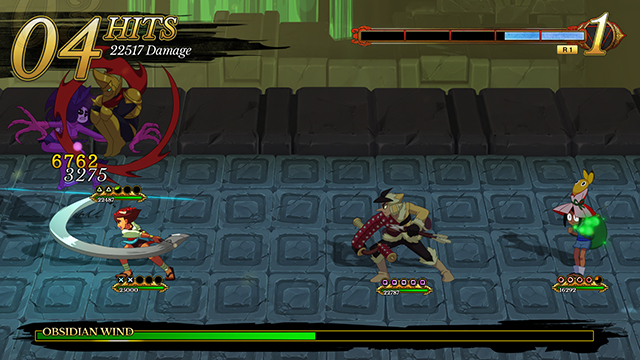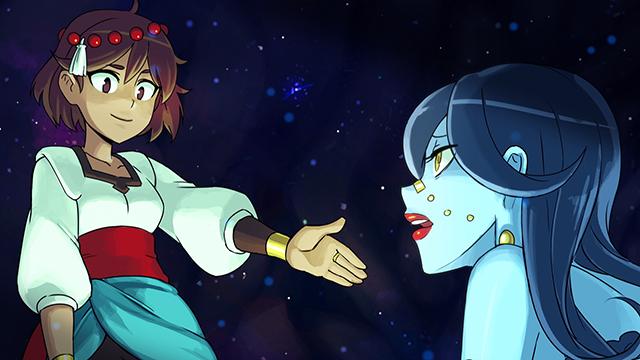Premier fighting game developers usually stick to that genre for years if not decades. Even though NetherRealm in its many forms has experimented with unique minigames and brawlers in the past, it has almost exclusively created traditional fighting games along with the Tekken team. Or, in Arc System Works’ case, it’s the genre the team is generally associated with. Developer Lab Zero Games has bucked that trend by developing INDIVISIBLE, its RPG platformer follow-up to Skullgirls. Indivisible’s expanded scope gives it the freedom to tell an engaging story with a unique battle system that contains satisfying hints of its pugilistic predecessor, yet still plays like a developer’s first stab into a new genre.
“Genres” is perhaps more apt, given that Indivisible is both an RPG and a platformer with light Metroidvania vibes. Players jump and traverse around until they strike (or get struck by) an enemy, which is where it shows its true RPG colors. Two disparate styles naturally give the game an organic change of pace since both are so wildly different from one another. And that difference also pertains to each’s quality.
Indivisible Review | Everyday I’m jugglin’

Combat could be best summarized as a newer version of Valkyrie Profile but, given its status as an obscure Enix PS1 game from 1999, it’s probably better to break it down into individual parts. Although loosely defined turns determine who gets to attack, each of the four allies is relegated to a face button that gives them the ability to strike when you command them to during your turn. That same button also defends said character against attacks during the opponent’s turn and better timing means you’ll take less damage.
ALSO: Why Indivisible is an RPG and not a fighting game Skullgirls follow-up
Steady timing isn’t just rewarded for defense, but also offense. Channeling its Skullgirls roots, it’s possible to pop foes into the air with one character while another one juggles them. Prolonged aerial combos net you more mana for special moves but, more importantly, is an active way to participate in combat, which is something not all RPGs have.
Turn-based RPGs can have more strategic elements but can also feel like spectator experiences that might get a little dry at times. Real-time RPGs alleviate that problem by having more on-screen action, but can end up sacrificing some of their depth for flash. By giving players the tactical setup of a turn-based game while rewarding quick reflexes and well-timed aerial juggles, Indivisible splits the difference in a way that mostly pulls the best from both styles during offensive onslaughts and while defending against attacks.
Indivisible Review | Repetitive-playing game

At least it does from the outset. Indivisible has a solid core that shows promise in the beginning, yet fails to evolve and stay fresh during its 30-hour runtime. Battling a tiny potted monster in the first hour is almost structurally the same as the godlike final boss: mash the attack buttons, defend, use a special move, and then repeat. Little is introduced to keep players guessing and on their toes, like unique patterns, status ailments, or new ways to attack, meaning the fundamentally strong combat is put into a position where it becomes a repetitive routine.
Indivisible gets more repetitive as it continues as it doesn’t even require players utilize the best part of its combat: the ability to perform lengthy aerial combos. While never a difficult game, the latter half is insultingly easy for anyone who has been regularly fighting grunts along the journey. The drive to perform satisfying combos peters out as doing so only prolongs battles and is never the deciding factor between victory and defeat. Games should always be pushing players to play them in the ways that best show off their mechanics. And by making the combat a cakewalk, it lets users disengage from its combo-based nature and meander through fights by mindlessly mashing. Flashy, fluid animation and meaty sound effects make these spectacles visually engaging, even if they aren’t always as mechanically so.
An absence of variety hurts the game’s combat in some areas, while an abundance of variety hurts it in others. Indivisible has a stunning array of creatively designed party members to choose from and each have their own uses during battle. But breadth does not equal depth.
You acquire crew members at an alarming rate, one that doesn’t allow for players to meaningfully try out every single character. Choice paralysis strikes as you open the menu and since the game is incredibly easy, there’s little outside of sheer curiosity to push you to stray too far from what works. While some are quite useful, the game would be better served if most of these characters were folded into others. Fewer, deeper party members would benefit the game narratively and mechanically, as there wouldn’t be as many characters that don’t have much to contribute.
Indivisible Review | An RPG without many RPG elements

But this sadly isn’t quite how the game is structured and mostly speaks to its bizarre lack of RPG-like features like upgrades or customization. There are no skill points, upgrade trees, or abilities to choose from and is partly why the experience stagnates after you learn the basics.
Swapping out abilities or choosing how to further your characters would add more strategic elements and is where those aforementioned filler fighters would find a role. If they were boiled down to mere abilities rather than whole characters, the roster would be more streamlined and the combat would have more options. Being able to upgrade your health through collectibles is a decent start, but only that: a start to RPG mechanics that don’t exist. Not every game needs loot or extensive skill trees, but this specific game could have been better if had dared to go a little further and embrace its RPG roots more extensively.
Indivisible technically does have upgrades in its platformer half. And the platforming improves with each gained skill, demonstrating how new abilities can better a game as it layers in additional elements. It missed an opportunity by not implementing these moves into the combat like Guacamelee, but it does lend a small sense of progression that isn’t there in the gameplay system that asks for it the most.
Despite its advancements, platforming can be frustrating at times due to its occasionally cumbersome controls. The axe ledge grab, the most basic ability that lets you cling to walls, requires that you hold the button as opposed to tapping it and that delay can easily throw you off. Many of the moves have this sort of deliberate input so instead of gracefully bouncing around, you will often fall because you didn’t hold a button for long enough. Combined with multiple moves that require different directional inputs and platforming becomes more about bending your fingers in the right ways and inputting moves a tad too early, which isn’t as satisfying as a platformer that focuses on more simplistic moves.
Leaps also peak early and hardly move you forward and when a jump — the core move in almost every platformer — is weak, the whole game is likely to suffer as a result. Platforming isn’t punishing and hardly a bad time, but it’s not quite as tight as it should be, especially when looking at the bland level structure that mostly feels like a bunch of square hallways linked together. The banal landscapes could have partially avoided this fate if they were also rendered with the same beautiful style of the crisp, 2D models over visually inconsistent 3D backgrounds. This aesthetically boring level design is particularly egregious in the last stage that drags on for far, far too long.
Indivisible Review | Learning to forgive

That level at least makes sense for the climactic story, which is the game’s strongest asset. The game stars Ajna, a teenage girl who is out to exact revenge, find out about her past, and stop an apocalyptic god bent on destroying the universe.
Theoretically, Indivisible’s story reads like the most basic, cliché-ridden RPG tale, but it succeeds through how it tackles that subject. Ajna, the protagonist, is a brash, naive teenager with a pure, wholesome heart, but is too young to truly take on the responsibility that is thrusted on her. She often fails to think ahead and damns people she’s supposed to protect because of her short-term problem-solving skills.
Atoning for bad behavior and righting your wrongs are key ideas that the game wonderfully explores through Ajna as well as a decent portion of the cast. Multiple characters also go through similar journeys, creating a cohesive and effective central message while also humanizing the cast and giving them convincing arcs. It even uses this to set up a courageous story beat around the halfway mark that shows how committed the game is to its themes. Aside from the cringeworthy cat lady, the strong vocal performances make these characters likable enough but their ability to grow is what adds the necessary personal touch that keeps it from being another RPG.
Apart from its nuanced storytelling, Indivisible is a brilliant vertical slice of a more fully featured game that doesn’t exist. Almost all of its ideas seem like prototypes stuck in their early phases that are waiting to be fleshed out. Combat skillfully draws from both real-time and turn-based RPGs, but doesn’t go much beyond its strong premise and ends up stagnating. Leveling up is basic and doesn’t yield new gear or moves. And the multiple traversal abilities you do gain don’t control well enough to turn the game into a top-tier platformer. Making a game in a genre outside of your wheelhouse is bound to have these kinds of issues. However, it has a lot of heart and its head is in the right place. And like the game’s most poignant themes, we are more than our mistakes and worth caring about despite them.
GameRevolution reviewed Indivisible on PS4 with a code provided by the publisher.
-
Lovely story that wonderfully explores themes of maturation, redemption, and forgiveness.
-
Characters are uniquely designed and well-animated.
-
Combat has a unique blend of real-time and turn-based rules...
-
...Yet its absence of variety makes it repetitive and too easy.
-
Lacks deep RPG gameplay systems like upgrades or skill trees.
-
Boring level design makes the tedious platforming even more tedious.











